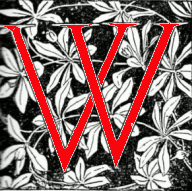
here did I first encounter Ruskin? That’s easy to recall. During the 1963-64 academic year in graduate school I took E. D. H. Johnson’s seminar at Princeton on Ruskin. Dudley begin by telling the five of us who had signed up for the class something that I have repeated to my students throughout the years. After pointing out that Ruskin is an incredibly rich and complex writer, he added “If you can understand Ruskin, you can understand the Victorian age.”
When I repeat his words I add, “He also can teach you how to see things and not just look at them. I know he taught me.” Reading Modern Painters gave me the tools — and the attitude — to see things I had never before noticed. I haven’t had many epiphanies in my life, but I believe Ruskin led me to one I experienced after the year I took that seminar. One night when I felt down, depressed, and a bit stale, I left my flat, crossed Witherspoon Street, and began walking when I caught sight of a tall bush or small tree whose leaves silhouetted against the light glowed at their edges. I suddenly felt as if I had never seen leaves before! Invigorated and filled with delight, I returned home and have never forgotten that brief moment when I saw things differently, almost certainly because I had read Ruskin.
Not surprisingly, over the years Ruskin led me to a wide range of subjects. Writing my dissertation on his aesthetic theories, which combine neoclassical and romantic modes of thought, lead to an understanding of the Victorian age — yes, as usual, Dudley was right — as one that combined eighteenth- and early nineteenth-century conceptions of art, literature, and a whole range of ideas, including those we now categorize as moral philosophy, aesthetics, and psychology. But since Ruskin began to write in order to defend Turner, I began to move in art history. Part of that new interest applying for and receiving a Fulbright to London, where I worked with the brilliant and wonderfully generous Geoffrey Tillotson and visited many of Turner’s paintings, quite a few then not yet restored, at the Tate in the company of Martin Butlin (yet another person to thank).
It was Tillotson who pointed out that Ruskin was yet another way into Victorian thought. I had written about Ruskin’s citation of Henry Melville (the Evangelical Chrysostom or golden-tongued) and his biblical typology in one of his letters to the Times in defence of William Holman Hunt and the Pre-Raphaelites. In his inimitable way Tillotson said, “You are on to something important” or “This is important.” This remark (if one understood it) meant that one should come back in a few weeks with a twenty- or thirty-page essay, and if it was good enough, Professor Tillotson would drop another golden suggestion. Pointing me toward biblical typology led to the last chapter of The Aesthetic and Critical Theories of John Ruskin and ultimately toward my books on Hunt and Pre-Raphaelite symbolism and Victorian Types.
Ruskin turned out to be related importantly to an entirely different interest of mine, one that has largely occupied the last quarter century, led to half a dozen books, and of which The Victorian Web is one result. I mean the theory and practice of hypertext, hypermedia, digital textuality, and their relation to the arts and society, particularly education. Hypertext, of which the WWW is an much attenuated, if enormously important, instantiation, presents texts linked together in a networks of connections. Who more than Ruskin requires and benefits from this kind of information technology? The Victorian Web originally began as a testbed or laboratory for investigating hypertext. One valid way of thinking about it would be as a network with Ruskin at one of its many centers.
Last modified 7 April 2024